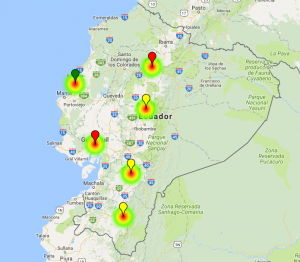Una forma de mostrar ciertos datos geolocalizados en un mapa, de Google, consiste en utilizar el módulo gmplot.
A continuación las instrucciones para obtener un mapa parecido a este:
Primero, instale el módulo gmplot:
- Mediante la línea de comandos:
pip install gmplot
- O, mediante PyCharm.
Vaya a File > Default Settings …

En la ventana que aparece, seleccione la opción de Project Interpreter. Luego, de clic en el símbolo + para agregar un módulo.
Finalmente, en esta ventana, agregue el nombre del módulo: gmplot. Y, de clic en Install Packages
Luego, obtenga la posición (latitud y longitud) del cualquier lugar que desee, en el sitio: http://www.coordenadas-gps.com/
Finalmente, las instrucciones en Python para graficar.
import gmplot
#Ubicar el centro del mapa en Ecuador
#Para esto, se necesita la latitud y la longitud de Ecuador:
#latitud: -1.831239
#longitud: -78.18340599999999
#Esta funcion necesita los siguientes argumentos: latitud, longitud, zoom
gmap = gmplot.GoogleMapPlotter(-1.831239, -78.18340599999999, 7)
#diccionario de ejemplos con las latitudes y longitudes
ciudades = {
"Guayaquil" : {"region":"costa","habitantes":2350915,"coordenada":(-2.1709979, -79.92235920000002)},
"Quito": {"region":"sierra","habitantes":2239191,"coordenada":(-0.1806532,-78.46783820000002)},
"Cuenca": {"region":"sierra","habitantes":505585,"coordenada":(-2.9001285, -79.0058965)},
"Bahia de Caraquez": {"region":"costa","habitantes":20921,"coordenada":(-0.6186619,-80.42736439999999)},
"Loja":{"region":"sierra","habitantes":214855,"coordenada":(-4.0078909,-79.21127690000003)},
"Ambato": {"region":"sierra","habitantes":329856,"coordenada":(-1.2543408,-78.6228504)}
}
#procesamos el diccionario para tener dos listas: latitud y longitud
latitud = []
longitud = []
for key in ciudades.keys():
lat, long = ciudades[key]["coordenada"]
habitantes = ciudades[key]["habitantes"]
#agregamos a la lista
latitud.append(lat)
longitud.append(long)
# Marcadores de Google: marker
#Por cada ciudad con menos de 1000000 (un millon) de habitantes
if habitantes > 1000000:
#vamos agregando uno a uno los datos de la latitud y longitud correspondientes
gmap.marker(lat,long,c='red')
elif habitantes > 100000:
gmap.marker(lat, long, c='yellow')
else:
gmap.marker(lat, long, c='green')
#Mapa de calor: heatmap
#recibe dos listas: latitud y longitud
#ademas del radio (radius) de calor
#Y, la opacidad (cuan opaco) desea el mapa de calor, en general.
gmap.heatmap(latitud, longitud,radius=30, opacity=0.9)
#graficar en un archivo html
nombreDeArchivo = "ecuador.html"
print("Archivo final: "+nombreDeArchivo)
gmap.draw(nombreDeArchivo)





 Some good news after 2 months and a half of hard work, guided by Gianmarco De Francisci Morales, I don’t have words to thank him for his time and advices along this process.
Some good news after 2 months and a half of hard work, guided by Gianmarco De Francisci Morales, I don’t have words to thank him for his time and advices along this process.